When Intel declared its new 9th gen Core i9-9900K the “world’s best gaming CPU,” it lied. After poking and prodding the CPU, we can say without a doubt that it is actually the fastest mainstream CPU around and—wait for it—the fastest gaming CPU too.
For those who watch every nuance of CPU movements like a degenerate gambler following the ponies, this news won’t exactly come as a shock. After all, take a 14nm++ (+?) CPU, throw on two more cores and crank the clock speed up to 5GHz almost all of the time, and it’s easy to see how the Core i9-9900K would top the charts.
The shocker to us wasn’t that it was fast, but just how fast, and how easy it was to make even faster.
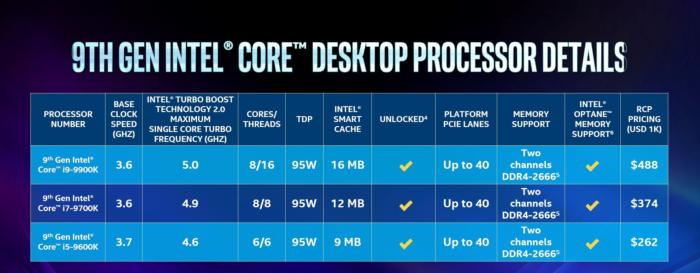 Intel
IntelIntel has three new 9th-gen CPUs in the stable and now offers an 8-core option.
Just what does 9th-gen even mean?
With this launch, Intel has decided to notch up its processor series to the 9th generation. We actually asked the company what the generation denomination meant years ago when it clicked over to 6th gen. Back then, Intel said it was related to the graphics core generations on the CPUs. With the 7th generation, Intel said even though the graphics cores were exactly the same, the changes to the media processing engine (technically part of the graphics core) was enough to count. Umm, OK.
With the 8th generation of CPUs, we didn’t even bother to ask, because it was clear it didn’t really mean anything except maybe newer and faster.
So if you want the short answer, 9th gen doesn’t mean anything except that it’s better than trying to call it New CPU Number 42. As far as we can tell, the x86 cores are the same as on the 8th gen CPU, and the graphics core, too.
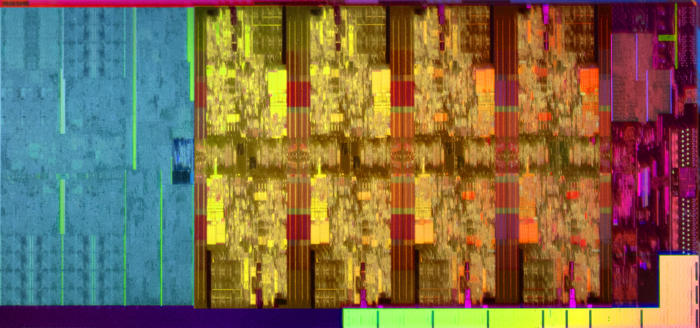 Intel
IntelSTIM and More Cores!
There is one key change with this generation, though: more cores. Obviously stung by AMD’s wildly successful 8-core Ryzen CPUs, Intel has decided to match AMD on core counts. The top-end CPU reviewed here, the Core i9-9900K, features eight cores with Hyper-Threading. Intel didn’t just glue on two more cores and call it a day, either. It also brought back a soldered thermal interface material, or STIM.
In the picture below, you’re not seeing the silicon chip itself, you’re seeing a metal heat spreader, which helps protect the delicate die from damage by, you guessed it, spreading the heat.
If you think of the silicon die as one side of an Oreo, and the metal heat spreader as the other side, the STIM is the white sugary stuffing that connects the two. Years ago with its 2nd-gen Sandy Bridge CPUs, Intel used solder TIM but suddenly changed to a likely cheaper paste (also called polymer) TIM. With Ryzen’s arrival, Intel likely needed a performance boost, and the STIM is just that.
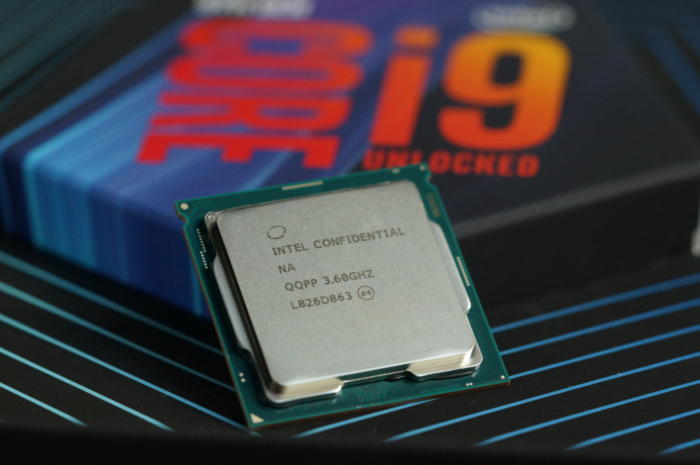 Gordon Mah Ung
Gordon Mah UngThe actual chip sits protected under the metallic (likely nickel-plated copper) heat spreader. With the 9th gen, Intel goes back to a soldered material rather than paste.
A new Z390 chipset, too
Paired with the new Core i9-9900K is Intel’s new Z390 chipset. For the most part, the only change of matter is native USB 3.1 Gen 2 (10Gbps speeds). The rest is the same except for wireless integration, which you don’t care about.
Backward compatibility with older motherboards is the best news: Intel said Z370 boards should fully support the new 9th-gen CPUs. Intel has taken heat in the past for requiring new motherboards with new CPUs, so let’s give credit where it’s due.
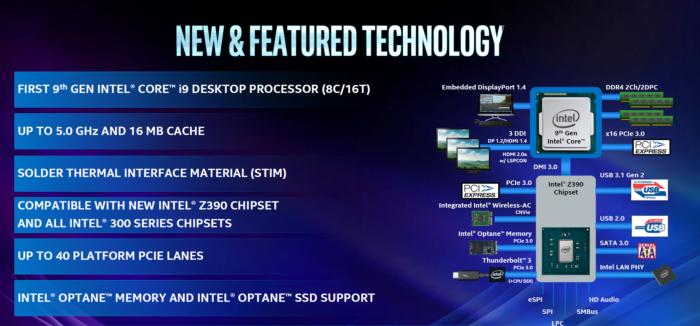 Intel
IntelThe only feature to truly care about on the Z390 chipset is native USB 3.1 10Gbps speeds.
How we tested
For this test, we used an engineering sample Core i9-9900K, along with an engineering sample Core i7-8700K and an early-production AMD Ryzen 7 2700X, provided directly by AMD.
We tested the Core i9-9900K on an Asus Maximus XI Hero Z390 board, the Core i7-8700K on a Gigabyte Aorus Gaming 7 Z370 board and the Ryzen 7 2700X on an MSI X470 Gaming M7 AC motherboard.,
All three used two single-rank 8GB Geil Flare X DDR4/3200 DIMMs in dual-channel mode. XMP memory profiles were set for all three. For storage, we used three identical 250GB Kingston HyperX Savage MLC SATA drives.
We installed identical Founders Edition GeForce GTX 1080 cards on each testbed, using the latest available public drivers. All three were checked with GPU-only tests to ensure they performed consistently.
For cooling, we initially tried to use the stock AMD Wraith Spire Prism along with two aftermarket, Intel BXTS15A coolers with the fans at 100 percent. We decided the stock Intel air cooler wasn’t up to the task of the Core i9-9900K, so we switched to three Corsair H80i V2 AIO CLC coolers, with the fans set to 100 percent on all three and mounted in the same manner (external). All three systems were run with their side panel removed, with AC-powered fans blowing cool air over the GPUs and motherboards.
For OS, we used Windows 10 Home version 1803, along with the latest motherboard BIOSes and chipset drivers for each platform.
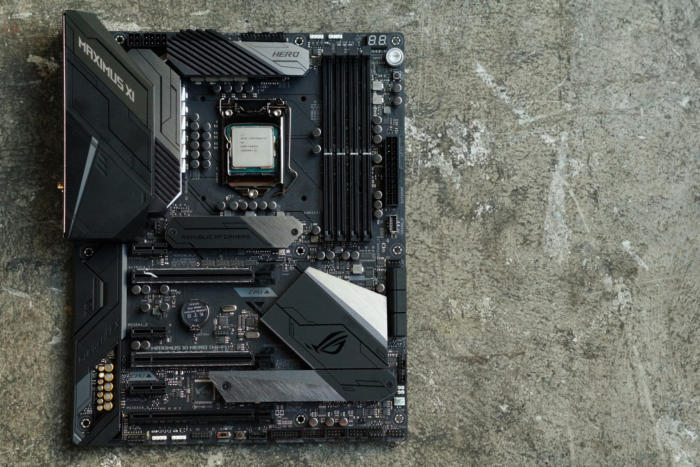 Gordon Mah Ung
Gordon Mah UngIntel’s new 9th-gen Intel Core i9-9900K in an Asus Maximus XI Hero Z390 mobo.
To MCE or not?
For the last five years or so, most Intel motherboards have provided an extra setting typically called “Multi-Core Enhancement.” MCE allows each motherboard maker to set higher targets for boost clocks. It’s technically overclocking, but it also isn’t because it’s enabled from the factory, so it doesn’t actually void your warranty.
Because MCE is part of the experience most consumers would get with a Core i9 on particular motherboards, we were really at odds about whether to enable it.
In the end, we didn’t enable it for our testing, but we did run additional tests on the Core i9 with MCE set to Auto and On, because somehow it felt fair to show just how easy it is to get that “free” performance.
For example, on our Maximus XI Hero board and with our Corsair H80i V2, setting MCE to auto gave us all core loads up to 4.7GHz during H.265 encoding. Setting it to On ran all cores up to 5GHz under fairly heavy loads most of the time.
This is just too much too much goodness to pass up, so we’ll point it out when it’s worth it.
Core i9-9900K 3D Modelling Performance
Let’s kick off our performance analysis using Cinebench R15. Based on Maxon’s Cinema4D engine (albeit slightly older), this is a real-world 3D rendering application.
Although we’re going to zero in on the freshest OS version for the bulk of our tests, we feel pretty comfortable showing how the Core i9-9900K stacks up against a raft of CPUs we’ve tested using prior OS versions. Like most 3D rendering apps, it loves core count—so we’re very interested in seeing how the high clocks of the Core i9 matter.
Although the Core i9-9900K can’t hang with 18-core and 32-core CPUs, the combination of its high clock speeds puts it in the running with the 10-core Core i9-7900X and the 10-core Core i7-6950X chip. And yes, the Core i7-6950X did indeed cost $1,723.
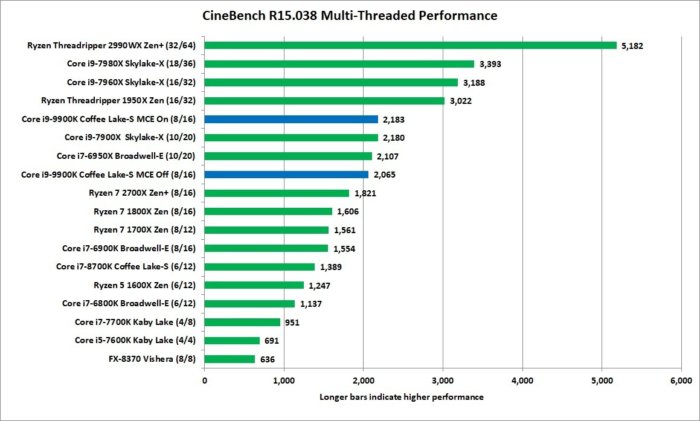 IDG
IDGCinebench R15 amazingly puts the Core i9-9900K above two 10-core CPU in a multi-threaded test. With MCE on, it’s the top of the heap of the mainstream CPUs.
The world isn’t about multi-threading, though, and single-threaded performance is often far more important for most of the work people do. To measure that, we also run Cinebench in single-threaded mode. As we did for the last test, we ran the Core i9-9900K with MCE on and MCE off.
It doesn’t really matter, though, because on a single core, the Core i9-9900K runs at 5GHz stock. The Core i9-9900K easily dominates the mainstream CPUs, as well as the workhorse chips that cost almost four times as much.
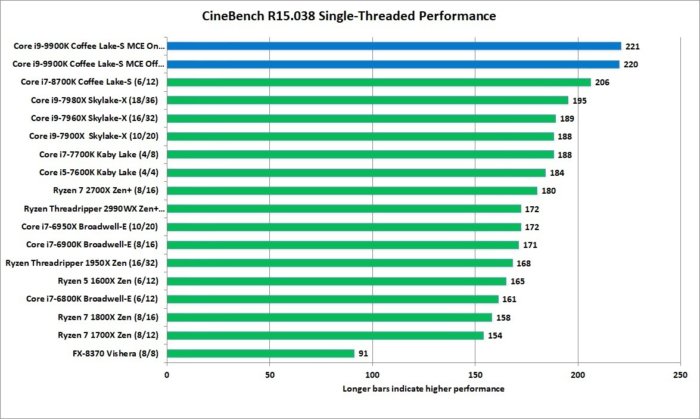 IDG
IDGThe Core i9-9900K dominates single-threaded performance thanks to its 5GHz turbo boost.
Our next test is the Corona Renderer. This is a photorealistic unbiased renderer. That may sound like it’s a test that doesn’t favor any hardware, but it actually refers to the rendering technique it uses.
We ran the Core i9 with MCE off, on auto, and manually turned on. For the most part, that means a long-term boost speed of all cores of 4.3GHz, 4.7GHz, and 5GHz.
In Corona, which uses all of those cores, we can see 16 threads at 5GHz pays off nicely.
 IDG
IDGThe Corona Renderer is an “unbiased” renderer.
Next up is V-ray, which is a physically-based renderer. More cores matter, and more cores at higher clocks seem to matter more. V-ray also appears to like Intel’s architecture more than AMD’s, as the Core i7-8700K creeps right up behind the Ryzen 7 2700X. Far ahead, though, is that Core i9-9900K.
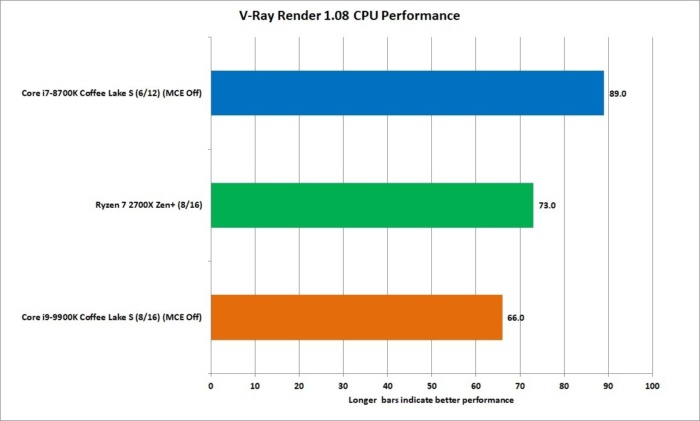 IDG
IDGV-Ray likes fast cores based on Intel, apparently.
Our next test is the open-source Blender program that’s popular among indie movie makers. We ran the Core i9 with MCE off, on auto, and manually turned on. Using the free BMW benchmark file, the Core i9 has a decent lead over the Ryzen 7 2700X, but not enough until you switch on MCE.
 IDG
IDGBlender is a popular and free 3D modelling application. For the most part, it’s a clock speed race between the 8-core CPUs.
Our last 3D modelling test is POV-Ray. It’s a ray tracing application that has its roots in the Commodore Amiga. In the built-in multi-threading test, it’s really a 4.3GHz 8-core vs. a 4GHz 8-core race, with the Core i9 coming in about 10 percent faster when set to stock speeds.
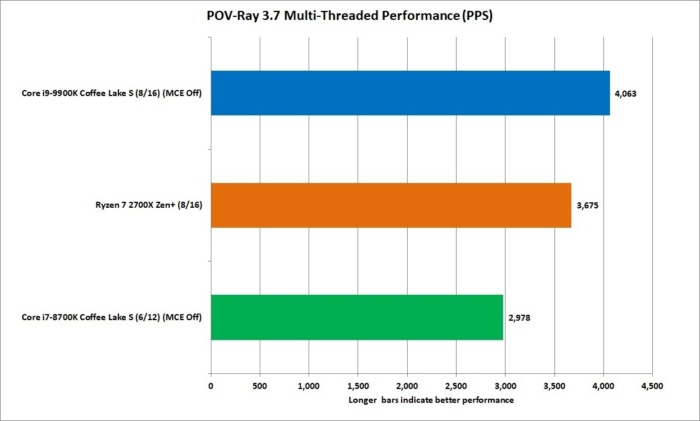 IDG
IDGPOV-Ray has the Core i9 about 10 percent faster than the Ryzen 7 2700X.
Where the Core i9 consistently pulls far ahead of the Ryzen 7 2700X is in lighter loads. In POV-Ray, the Core i9 is about 25 percent faster thanks to its high clocks. In fact, even the older Core i7-8700K passes the Ryzen 7 on the single-threaded test.
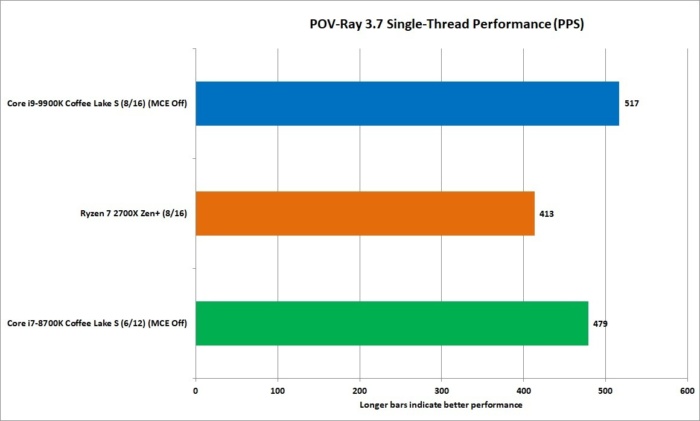 IDG
IDGRyzen just can’t beat Core i9 or Core i7 on single-threaded loads.
Need more proof? Keep reading for CPU benchmarks based on encoding and video editing.
